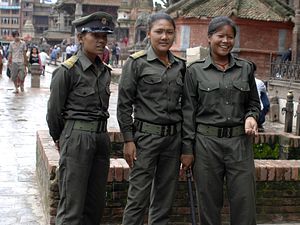Over the past six months, the Nepal Army (NA) has stepped up its engagement with the country’s economy. First, in December 2015, the NA declared that it will invest in a hydropower project for the first time. Then, on March 2016, the NA – in another first — got permission from the government of Nepal to run a textile factory inside the capital of Kathmandu. According to the NA, the factory will produce garments for army use. Finally, the Nepal Army has asked the Ministry of Industry to allow it to run the Hetauda Textile Industry (HTI), which has been closed since 2001. What is one to make of these events?
Nepal lacks adequate capital for investment purposes. Most of the country’s construction projects have been (and still are) funded by aid from external agencies. This reflects the shortage of capital and liquidity in the Nepali economy. From this point of view, the NA’s decision to invest in the economy represents huge progress. The Nepal Army Welfare Fund (NAWF), worth up to Rs. 35 billion ($330 million), is the primary source of capital for the NA. Until now, this capital has been kept in various commercial banks at a very low interest rate; the NA’s welfare programs are operated on the basis of the interest it earns from the banks. The recent moves to invest the principal amount itself are vital, as this will circulate billions of rupees of frozen capital, thus injecting liquidity to the economy.
The target industries are also strategically chosen. Nepal has recently undergone a terrible energy crisis, causing the government to declare an energy emergency. Thus, mobilizing NA capital to fund a hydropower project is a positive outcome for the energy sector as well as the economy. It may be a small investment compared to the present energy demand and crisis situation, but over the long term this investment could bring increased discipline to the hydropower projects, many of which are currently being hindered or held back by local as well as political obstructions.
Meanwhile, textiles and garments are major manufacturing commodities for Nepal; textile products are among the country’s top exports. However, textiles (particularly ready-made garments from India and China) are also one of the most imported and smuggled commodities. The operation of the NA garment factory in Kathmandu will at least decrease the army’s dependence on imported, ready-made garments. However, if the government allows NA to operate HTI, it will begin to produce textiles and garments for public use as well. This will increase mass production and decrease import dependence across the board. As an added incentive for increased production, certain Nepali textiles will enjoy duty-free access to the United State for the next ten years, according to the recent “Nepal Trade Preferences Act.” Given these factors, investment in the textile industry by the army is a good decision.
Investment from the military will push the economy in a positive direction by increasing revenue and decreasing imports. However, on the flip side, over the long run NA investment could end up harming the economy. For one thing, a single mass producing enterprise (such as HTI) could crowd out the small and medium enterprises (SMEs) involved in the textile sector. Currently, SMEs account for 75 percent of employment in Nepal’s industrial sector. Second, as of now the Nepal Army only has plans to produce garments for their own use. The production of goods for specific consumers can lead to inefficiency, waste, and even failure of the enterprise because the same organ – in this case the NA – is creating both supply and demand. To prevent such a scenario, the NA’s textile enterprise should undertake the mass production of textiles, primarily focusing on exports.
Politically, however, Nepal must be wary of the potential for the army to supersede the civilian government. Injecting money to resuscitate the textile industry, thus creating employment, is part of the populist agenda of Nepal’s political parties. Combined with the ongoing energy emergency in the country, the Nepal Army’s investment in these sectors could change public sentiment toward the army at the expense of the state. Also, in long run, if the army implements an expansionary policy in the economy and begins to produce a diverse range of goods, the army could gain a strong hold over the economy and change the balance of power between the state and the army. However, this scenario doesn’t seem likely at present.
Samridhi Pant is a Masters student of International Political Economy at S. Rajaratnam School of International Studies.

































